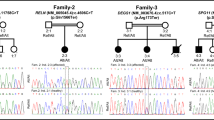Abstract
Adaptor-related protein complex 1 subunit sigma 2 (AP1S2) is a subunit of AP1 that is crucial for the reformation of the synaptic vesicle. Variants in AP1S2 have been reported to cause a rare neurodevelopmental disorder, Pettigrew syndrome (PGS) (OMIM: 304,340), which is characterized by walking delay, abnormal speech, mild to profound X-linked intellectual disability (XLID), and abnormal brain, and behaviors. Here, we describe a 2-year- and 5-month-old male patient who presented with global developmental delay (GDD). Trio whole exome sequencing (WES) revealed a 5 bp duplicate in the AP1S2 gene (NM_003916.5: exon 2: c.96_100dup, p. Leu34Glnfs*8) predicted to cause early termination of translation, which was inherited from the unaffected mother. The clinical features of our patient were consistent with previous reports. This is the second case in the Chinese family and the eleventh variant found in AP1S2-related XLID. Our findings expand the AP1S2 variant spectrum in neurodevelopmental disorders and provide evidence for the application of WES in PGS diagnosis.


Similar content being viewed by others
Data availability
The datasets used and analyzed during the current study are available from the corresponding author on reasonable request.
References
Fell CW, Nagy V (2021) Cellular models and high-throughput screening for genetic causality of intellectual disability. Trends Mol Med 27(3):220–230
van Bokhoven H (2011) Genetic and epigenetic networks in intellectual disabilities. Annu Rev Genet 45:81–104
Kochinke K, Zweier C, Nijhof B, Fenckova M, Cizek P, Honti F, Keerthikumar S, Oortveld MA, Kleefstra T, Kramer JM et al (2016) Systematic phenomics analysis deconvolutes genes mutated in intellectual disability into biologically coherent modules. Am J Hum Genet 98(1):149–164
Kaplanis J, Samocha KE, Wiel L, Zhang Z, Arvai KJ, Eberhardt RY, Gallone G, Lelieveld SH, Martin HC, McRae JF et al (2020) Evidence for 28 genetic disorders discovered by combining healthcare and research data. Nature 586(7831):757–762
Ropers HH (2008) Genetics of intellectual disability. Curr Opin Genet Dev 18(3):241–250
Lubs HA, Stevenson RE, Schwartz CE (2012) Fragile X and X-linked intellectual disability: four decades of discovery. Am J Hum Genet 90(4):579–590
Ropers HH, Hamel BC (2005) X-linked mental retardation. Nat Rev Genet 6(1):46–57
Tarpey PS, Stevens C, Teague J, Edkins S, O’Meara S, Avis T, Barthorpe S, Buck G, Butler A, Cole J et al (2006) Mutations in the gene encoding the Sigma 2 subunit of the adaptor protein 1 complex, AP1S2, cause X-linked mental retardation. Am J Hum Genet 79(6):1119–1124
Candiello E, Kratzke M, Wenzel D, Cassel D, Schu P (2016) AP-1/σ1A and AP-1/σ1B adaptor-proteins differentially regulate neuronal early endosome maturation via the Rab5/Vps34-pathway. Sci Rep 6:29950
Kratzke M, Candiello E, Schmidt B, Jahn O, Schu P (2015) AP-1/σ1B-dependent SV protein recycling is regulated in early endosomes and is coupled to AP-2 endocytosis. Mol Neurobiol 52(1):142–161
McKenna A, Hanna M, Banks E, Sivachenko A, Cibulskis K, Kernytsky A, Garimella K, Altshuler D, Gabriel S, Daly M et al (2010) The genome analysis toolkit: a MapReduce framework for analyzing next-generation DNA sequencing data. Genome Res 20(9):1297–1303
Jumper J, Evans R, Pritzel A, Green T, Figurnov M, Ronneberger O, Tunyasuvunakool K, Bates R, Žídek A, Potapenko A et al (2021) Highly accurate protein structure prediction with AlphaFold. Nature 596(7873):583–589
Waterhouse A, Bertoni M, Bienert S, Studer G, Tauriello G, Gumienny R, Heer FT, de Beer TAP, Rempfer C, Bordoli L et al (2018) SWISS-MODEL: homology modelling of protein structures and complexes. Nucleic Acids Res 46(W1):W296-w303
Pettersen EF, Goddard TD, Huang CC, Couch GS, Greenblatt DM, Meng EC, Ferrin TE (2004) UCSF Chimera–a visualization system for exploratory research and analysis. J Comput Chem 25(13):1605–1612
Kongsvik TL, Höning S, Bakke O, Rodionov DG (2002) Mechanism of interaction between leucine-based sorting signals from the invariant chain and clathrin-associated adaptor protein complexes AP1 and AP2. J Biol Chem 277(19):16484–16488
Baust T, Czupalla C, Krause E, Bourel-Bonnet L, Hoflack B (2006) Proteomic analysis of adaptor protein 1A coats selectively assembled on liposomes. Proc Natl Acad Sci U S A 103(9):3159–3164
Borner GH, Harbour M, Hester S, Lilley KS, Robinson MS (2006) Comparative proteomics of clathrin-coated vesicles. J Cell Biol 175(4):571–578
Takatsu H, Sakurai M, Shin HW, Murakami K, Nakayama K (1998) Identification and characterization of novel clathrin adaptor-related proteins. J Biol Chem 273(38):24693–24700
Glyvuk N, Tsytsyura Y, Geumann C, D’Hooge R, Hüve J, Kratzke M, Baltes J, Boening D, Klingauf J, Schu P (2010) AP-1/sigma1B-adaptin mediates endosomal synaptic vesicle recycling, learning and memory. Embo j 29(8):1318–1330
Huo L, Teng Z, Wang H, Liu X: A novel splice site mutation in AP1S2 gene for X-linked mental retardation in a Chinese pedigree and literature review. Brain Behav 2019, 9(3):e01221.
Acknowledgements
We wish to gratefully thank the patient’s parents for allowing us to publish this clinical report. And also thank Cipher Gene for their sequencing knowledge support. This work was supported by Joint Open Research Fund of Henan Key Laboratory of Child Brain Injury and Henan Pediatric Clinical Research Center (KFKT2021102), the Henan Medical Science and Technique Foundation (212102310221, LHGJ20190337), and the national Health Commission Key Laboratory of Birth Defects Prevention and Henan Key Laboratory of Population Defects Prevention (2021-03).
Author information
Authors and Affiliations
Contributions
DZ and MW conceived and designed the experiments. YX and JZ did the patient recruitment and clinical analysis. FY and ZY did the WES and molecular analysis. DZ wrote the first draft of the manuscript. All authors reviewed and approved the final manuscript.
Corresponding author
Ethics declarations
Conflict of interest
The authors declare that they have no competing interests.
Additional information
Publisher's note
Springer Nature remains neutral with regard to jurisdictional claims in published maps and institutional affiliations.
Supplementary Information
Below is the link to the electronic supplementary material.

Supplementary Fig. 1
(PNG 987 KB)
10048_2022_691_MOESM1_ESM.tif
High Resolution Image MRI results. (a). A high single of T2 FLAIR was noted. (b). DWI was normal with no diffusion limitation. The short corpus callosum is shown in (c). No obvious abnormality was shown in the repeat MRI examination (d-f).Abbreviations: DWI, diffusion-weighted imaging; FLAIR, fluid-attenuated inversion recovery. (TIF 6945 KB)
Rights and permissions
About this article
Cite this article
Zhu, D., Wang, M., Xu, Y. et al. Identification of a 5 bp duplicate in the AP1S2 gene of an individual with X-linked intellectual disability. Neurogenetics 23, 179–185 (2022). https://doi.org/10.1007/s10048-022-00691-8
Received:
Accepted:
Published:
Issue Date:
DOI: https://doi.org/10.1007/s10048-022-00691-8




